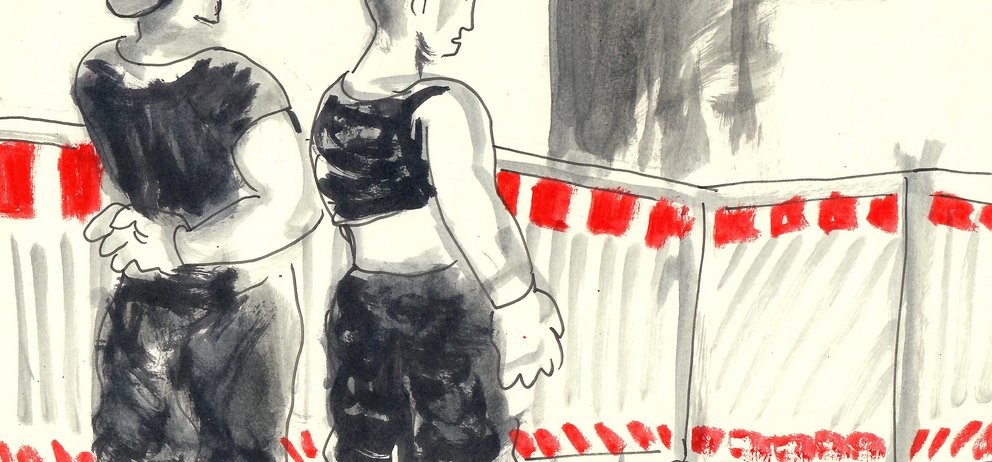By Stella Konstantinou, Volkan Türeli (HAU to connect), Nadine Vollmer (freelance dramaturge) and the team of HAU Hebbel am Ufer
We had planned a big programme for this summer, a block party, a festival at Mehringplatz. The occasion: ten years of Houseclub, and it was supposed to be about the neighbourhood, because that's part of the Houseclub. It's an important connection between the HAU and its immediate surroundings: most of the students live at Hallesches Tor or Mehringplatz, and the Houseclub is part of their everyday school life. For example, with the performance “It's a battlefield, baby” they opened the HAU festival “Berlin bleibt!” in 2019, sharing with the audience their research and experiences on housing and urban politics in and around Mehringplatz .
But for many neighbours, HAU is still not a part of their everyday live as a matter of course – as has unfortunately become the case with the construction site at Mehringplatz, which has been going on for ten years, just as long as the Houseclub. This detachment from everyday life is by no means a unique selling point of HAU. How can a cultural or art institution become even more accessible and inclusive, truly a place for everyone?
For more than a year – with a brief exception – the stages have been closed to audiences, and the theatre as a place of assembly has had to take a break. Even outdoor events in public space with a larger number of participants could hardly be planned and realised until May, so our festival cannot be what it was supposed to: a place for exchange and profound encounters. Since the beginning of the pandemic, we have reached our audience via the digital stage HAU4, regardless of time and place. But how can we better reach the people who live just around the corner? How can we come together? How do their issues reach the theatre under these challenging conditions? How can we as a theatre continue to be part of the immediate neighbourhood or connect with it even more so than in previous years?
We understand our craft as an art that creates encounters. But we don't want these to just show what we do; we want to change and readjust what we're doing. We want to understand knowledge as a collective work on “shared knowledges”, as the feminist and anti-racist bell hooks says*. Theatre and art can also mean unlearning what has already been rehearsed, but at their best, they can be resistant. We also know that theatre and art institutions are sometimes not very flexible and stay inside their own world. So what do we need to change, try things out, reinvent? HAU to connect? HAU has been taking steps towards self-questioning and readjustment for a long time. This needs to be expanded and taken further as a process. This includes contradictions, controversies and failed attempts (speaking of construction sites).
After all, it's worth asking: Are the construction workers or those directly affected by the construction site also on stage or in the audience? Very rarely, if ever. And are those who work for the stage familiar with it, or at least curious and open-minded enough to understand the construction site and those affected by it? These are not new questions, but they're still relevant. And it gets even more complicated: the Mehringplatz construction site is located in the middle of a redevelopment area, almost in the centre of Berlin, but the residents feel forgotten. Many businesses have closed, and a new business concept is currently being developed by the redevelopment advisory board. Housing policy is in a highly critical phase of development: municipal housing associations versus private ownership in the hands of real-estate companies, rents as profit, absurdly rising land prices, redevelopment backlog amounting to millions. What a construction site!
We've been listening to residents, stakeholders and the neighbourhood council, in which the HAU is involved, in ongoing conversations: What are the current developments in the immediate vicinity, and what effect do they have on the people, the city and the theatre? What urgency do these issues have beyond Kreuzberg and Berlin? A construction site does not affect everyone the same. How can art and culture react sensitively to social inequality? Ultimately, what kind of city do we want to live in, and how can we help shape it?
With “Berlin bleibt! #3 Werkstatt Mehringplatz”, we're extending an invitation, negotiating, trying things out. This includes getting to know each other, asking questions, listening, making proposals, identifying common interests, building trust and even arguing and fighting. It's not an art institution delivering a programme and then just disappearing again. Rather, it is about breaking out of the usual patterns, becoming more process-oriented and perhaps also slowing down with the means of art. Like a self-selected construction site, whose plan only emerges during the building process itself. Blueprints and building materials are agreed upon together. We will be on site for a while and hope that the theatre will manage to be open and relevant to new comrades-in-arms and young people. So, let's take all the time that's needed, and we'll have the party later.
This publication itself is part of the workshop, somehow unfinished and welcoming everyone: Drop by. See what we are working on together. We're presenting artistic processes that have already begun, as well as participants with whom we are already collaborating or plan to collaborate. We are especially grateful to them and to the residents for the in-depth exchange and cooperation. We know that we are far from having met everyone, but we are on our way.
This time, we will meet in the neighbourhood, outside the artistic display window at Friedrichstraße 4 or digitally in workshops and other forms of meeting. And in 2022, definitely live and in colour on Mehringplatz.
